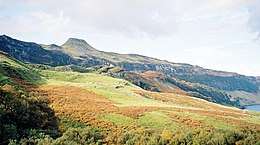Sorley MacLean
| Sorley MacLean FRSL FRSE Hon FRIAS HRSA FEIS | |
|---|---|
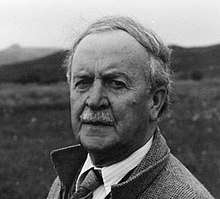 MacLean at Braes, Skye in 1986 | |
| Native name | Somhairle MacGill-Eain[lower-roman 1][lower-roman 2] |
| Born |
26 October 1911 Òsgaig, Raasay, Scotland |
| Died |
24 November 1996 (aged 85) Inverness, Scotland |
| Resting place | Stronuirinish Cemetery, Portree |
| Occupation |
English teacher Head teacher |
| Language | Scottish Gaelic |
| Education |
Raasay Primary School Portree Secondary School |
| Alma mater | University of Edinburgh |
| Genre | Gaelic poetry |
| Notable works |
Dàin do Eimhir
|
| Notable awards |
Queen's Gold Medal for Poetry
|
| Years active | 1932–c. 1980 |
| Spouse | Renee Cameron (m. 1946) |
| Children | Three daughters |
| Website | |
|
www www | |
Sorley MacLean (Scottish Gaelic: Somhairle MacGill-Eain;[lower-roman 1][lower-roman 2] 26 October 1911 – 24 November 1996) was a Scottish Gaelic poet, described by the Scottish Poetry Library as "one of the major Scottish poets of the modern era" because of his "mastery of his chosen medium and his engagement with the European poetic tradition and European politics".[2] Nobel Prize Laureate Seamus Heaney credited MacLean with saving Scottish Gaelic poetry.[3]
He was raised in a strict Presbyterian family on the island of Raasay, immersed in Gaelic culture and literature from birth, but abandoned religion for socialism. In the late 1930s, he befriended many Scottish Renaissance figures, such as Hugh MacDiarmid and Douglas Young. He was wounded three times while serving with the British Army during the Second World War, but disdained the traditional Gaelic worship of heroism. After the war, he published very little poetry, due to his perfectionism. In his later years, he became head teacher at Plockton High School, where he advocated for the use of the Gaelic language in formal education.
In his poetry, MacLean juxtaposed traditional Gaelic elements with mainstream European icons and current events, frequently comparing the historic injustice of the Highland Clearances with contemporary events, especially the Spanish Civil War. His work was a unique fusion of traditional and modern elements that has been credited with restoring Gaelic tradition to its proper place and reinvigorating and modernizing the Gaelic language.
Although his most influential works, Dàin do Eimhir and An Cuilthionn, were published in 1943, he did not become well known outside the Gaelic-speaking world until the 1970s, when his works were published in English translation. His later poem Hallaig, published 1954, achieved "cult status"[4]:134 outside Gaelic-speaking circles for its supernatural representation of a village depopulated in the Highland Clearances and came to represent all Scottish Gaelic poetry in the English-speaking imagination.
Biography
Early life
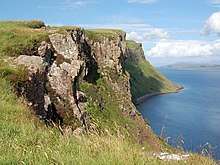
Sorley MacLean was born at Òsgaig on the island of Raasay on 26 October 1911; Scottish Gaelic was his first language. Before he went to school at the age of six, he spoke very little English.[5]:23[6]:194 He was the second of five sons born to Malcolm (1880–1951) and Christina MacLean (1886–1974). His brothers were John Maclean (1910–1970), a schoolteacher and later rector of Oban High School, who was also a piper;[7][5]:27 Calum Maclean (1915–1960), a noted folklorist and ethnographer; and Alasdair (1918–1999) and Norman (c.1917–c.1980), who became general practitioners. MacLean's two younger sisters, Isobel and Mary, were also schoolteachers.[8][7][9] Sorley's patronymic was Somhairle mac Chaluim 'ic Chaluim 'ic Iain 'ic Tharmaid 'ic Iain 'ic Tharmaid; he could not trace his genealogy with certainty to the eighth generation.[1]:211
At home, he was steeped in Gaelic culture and beul-aithris (the oral tradition), especially old songs. His mother, a Nicolson, had been raised near Portree, although her family was of Lochalsh origin;[2][3][10] her family had been involved in Highland Land League activism for tenant rights.[11]:231 His father, who owned a small croft and ran a tailoring business,[12]:16 had been raised on Raasay, but his family was originally from North Uist and, before that, Mull.[8][9] Both sides of the family had been evicted during the Highland Clearances, of which many people in the community still had a clear recollection.[11]:231-2 Both his mother's and father's families contained individuals who were considered accomplished by their communities, whether through formal education or extensive knowledge of the oral tradition.[8] What MacLean learned of the history of the Gaels, especially of the Clearances, had a significant impact on his worldview and politics.[11]:231 Of especial note was MacLean's paternal grandmother, Mary Matheson, whose family had been evicted from the mainland in the 18th century. Until her death in 1923, she lived with the family and taught MacLean many traditional songs from Kintail and Lochalsh.[8] As a child, MacLean enjoyed fishing trips with his aunt Peigi, who taught him other songs.[9] Unlike other members of his family, MacLean could not sing, a fact that he connected with his impetus to write poetry.[12]:17[13]
Calvinism

MacLean was raised in the Free Presbyterian Church of Scotland, which he described as "the strictest of Calvinist fundamentalism".[14] Calvinism taught that God would save a small portion of humanity, the elect, while the vast majority were doomed by the sinfulness inherent in human nature. Only 5% of the congregation took communion; the remainder were considered mere "adherents" who were probably destined for eternal torment in hell. Free Presbyterians believed that the Free Church was too lenient, let alone the Church of Scotland. They prohibited any form of amusement on the Sabbath, but had a rich tradition of unaccompanied psalm singing.[12]:17[15]:8
MacLean later said that he had abandoned religion for socialism at the age of twelve,[12]:17 as he refused to accept that a majority of human beings were consigned to eternal damnation.[11]:232 Nevertheless, the pessimism of the Calvinist tradition had a strong impact on his world-view, and he also retained "a puritanical contempt for mere worldly riches and power".[3][12]:32, 38[lower-roman 3] Later in life, he had a complicated view of the church and religion. Although he criticized the church's suppression of Gaelic song and the oral tradition and the negative effect of church teachings on some social groups, especially women, Professor Donald Meek (gd) pointed out that at times MacLean seemed to articulate the ideas of liberation theology.[3] MacLean defended the Free Presbyterian Church against opponents who had little familiarity with it,[12]:17[17] once describing Free Presbyterian elders as "saintly, just saintly men".[1]:218 Sometimes he even altered his poetry to avoid offending the religious members of his family.[18]:452 He also admired the literary sophistication and creativity of Protestant sermons in Gaelic.[1]:216-217 The wide vocabulary, high register, and passion of these sermons had a significant impact on his poetic style.[12]:17[11]:239[lower-roman 4]
1930s
He was educated at Raasay Primary School and Portree Secondary School.[8][3] In 1929, he left home to attend the University of Edinburgh.[3] For economic reasons, he chose to study English instead of Celtic.[lower-roman 5][12]:16[9] He disliked the head of the English department, Herbert Grierson, who favoured different poets than MacLean; MacLean felt that Grierson imposed his aesthetic preferences on the department. MacLean's academic work has been described as merely "dutiful".[20]:2 While at Edinburgh, MacLean also took classes in the Celtic department, then under William J. Watson.[9] He was involved in left-wing politics, literary circles, and the university shinty team.[10][19] MacLean later described an occasion in which he had demonstrated against Oswald Mosley and the British Union of Fascists.[17] According to Celtic scholar Emma Dymock, MacLean's education at Edinburgh broadened his horizons and the city itself was significant in his life.[10] While in Edinburgh, he observed urban poverty, slums, and overcrowding, especially severe due to the Great Depression.[15]:9 After his graduation in 1933 with a first-class degree, rather than pursuing postgraduate studies[12]:16[9] he remained in Edinburgh and spent a year at Moray House Teachers' Training College, where he met Hugh MacDiarmid.[19]
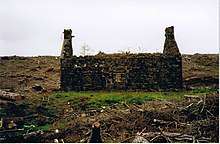
In 1934, he returned to Skye to teach English at Portree High School.[3][10] After the outbreak of the Spanish Civil War in 1936, he considered volunteering to fight in the International Brigades; according to his daughter, he would have gone if not for family responsibilities.[3] At the time, his mother was seriously ill and his father's business was failing.[21] In January 1938, MacLean accepted a teaching position at Tobermory High School on Mull, where he stayed until December.[21][22]:145 The year he spent on Mull had a profound effect on him, because Mull was still devastated from nineteenth-century clearances in which many MacLeans had been evicted.[4]:125-6[22]:145 MacLean later said, "I believe Mull had much to do with my poetry: its physical beauty, so different from Skye’s, with the terrible imprint of the clearances on it, made it almost intolerable for a Gael." He believed that fascism was likely to emerge victorious in Europe, and was further dismayed by the continuing decline of the Gaelic language.[21][5]:29
Between 1939 and 1941, he taught at Boroughmuir High School in Edinburgh, and in Hawick.[3][10] During this period, he wrote most of the poetry that would become Dàin do Eimhir, including the epic An Cuilthionn. MacLean cultivated friendships with Scottish Renaissance poets, including MacDiarmid, Robert Garioch, Norman MacCaig, Douglas Young, and George Campbell Hay.[20]:4[9] MacLean, also a noted historian, published two influential papers on nineteenth-century Gaelic poetry in Transactions of the Gaelic Society of Inverness in 1938 and 1939, which challenged the Celtic Twilight view of Gaelic literature. MacLean accused the "Celtic Twilightists" with "attributing to Gaelic poetry the very opposite of every quality which it actually has", at which they only succeeded because they catered to a credulous English-speaking audience. He pointed out that the apparent sentimentality or impotence of the corpus of Clearance poetry may have been an artefact of the fact that landlords would not have preserved poetry critical of them.[23]:124-6 His use of Gaelic poetry as a potential source material for historical studies was extremely innovative at the time.[23]:122-3
World War II
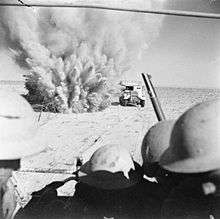
Upon the outbreak of war in 1939, MacLean wanted to volunteer for the Cameron Highlanders but was prevented due to the shortage of teachers.[3] He was drafted into the Royal Corps of Signals in September 1940 and was sent overseas to North Africa in December 1941.[21][22]:146 In the North African Campaign, he served with the Royal Horse Artillery[lower-roman 6] and was wounded on three occasions, but on the first two not severely enough to be classified as a casualty.[10][15]:5 His military career ended in November 1942 during the Second Battle of El Alamein, when he was at a command post when a land mine exploded nearby, throwing MacLean thirty feet through the air. He was wounded in the leg and broke several bones in his feet.[12][15]:5[lower-roman 7] MacLean wrote a few poems about the war in which he challenged the traditional Gaelic exaltation of heroism, exemplified by the lament for Alasdair of Glengarry; he viewed physical courage as morally neutral, since it was also valued by Nazis and used for evil ends.[12]:29
MacLean returned to Britain for convalescence in March 1943. He was discharged from Raigmore Hospital in Inverness in August 1943 and released from the army in September.[21][9] In the fall of 1943, he resumed teaching at Boroughmuir, where he met Renee Cameron in 1944.[lower-roman 8] They married on 24 July 1946 in Inverness and had three daughters and six grandchildren. According to friends, their marriage was happy and peaceful, as they complemented each other well, and MacLean "mellowed" with age and family life.[24][25][20]:5 He had never been a member of the Communist Party,[12]:17 and the Soviet occupation of Poland after the war caused MacLean to become disillusioned with the Soviet Union and Stalinism. He retained his socialist world-view and strong belief in social justice.[12]:32[20]:4 During this period, he frequently reviewed poetry and continued to make friends in literary circles, including younger poets such as Iain Crichton Smith and George Mackay Brown.[20]:4 He became particularly close to Sydney Goodsir Smith, who shared a flat with MacLean and his family for more than a year. In 1947 he was promoted to Principal Teacher of English at Boroughmuir, but MacLean wanted to return to the western Highlands.[25]
Later life
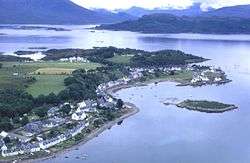
In 1956, MacLean was offered the position of head teacher of Plockton High School in Wester Ross, not far from where his paternal grandmother's family had lived. It was a difficult assignment as the remote location was not attractive to teacher candidates, and MacLean frequently had to teach himself due to vacancies.[26] While at Plockton, he promoted the use of Scottish Gaelic in formal education and campaigned for a Highers exam for learners of Gaelic.[4]:127 Before 1968, there was no separate exam for Gaelic learners, who had to compete with native speakers if they took Gaelic Highers. MacLean felt that this unfair policy discouraged many students from studying Gaelic, although he encouraged his students to take the exam even if they were not native speakers.[5]:34[lower-roman 9] In 1966, he presented a paper to the Gaelic Society of Inverness outlining the practical issues in Gaelic education. MacLean pointed out that in continental Europe, it was not uncommon to study three or four languages in school. According to MacLean, Scottish children would benefit from studying three languages in school alongside English, and "surely it is not expecting too much of Gaelic patriotism to demand that Gaelic should be one of the three?"[26][lower-roman 10] MacLean set high academic expectations for his students[17] and also promoted shinty; in 1965, the Plockton team won the cup for Ross and Cromarty.[26]
MacLean's many friends and visitors commented on his prodigious knowledge and deep interest in genealogy and local history.[28][17] He continued to participate in left-wing politics, eventually joining the Scottish Labour Party.[17] During his later years, he published few poems due to his "concern with quality and authenticity over quantity";[28][26] his family responsibilities and career left him little spare time to write.[20]:5 MacLean said that he had burned his poetry instead of publishing it because of his "long years of grinding school-teaching and [his] addiction to an impossible lyric ideal".[19][2]
After his retirement in 1972, MacLean moved to his great-grandmother's house at Peinnachorrain in Braes on Skye, with views over the Sound of Raasay, where he entertained frequently.[29][17] Following the English publication of his poetry, he began be in demand internationally for poetry readings, for which he traveled to such places as Rotterdam, Baddeck Cape Breton, and Berlin.[20]:5[30][29] MacLean was writer in residence at the University of Edinburgh from 1973 to 1975,[2][10] where he reportedly kept an open door and warm welcome for aspiring Gaelic poets.[31]:1 Later, he was the first filidh at the recently founded Sabhal Mòr Ostaig, a Gaelic-medium university on Skye, from 1975 to 1976.[2] He was involved in founding the institution and also served on its board.[32] In 1993, his daughter Catrìona died at the age of 41; MacLean and his wife helped to raise her three children. The poet died of natural causes on 24 November 1996, aged 85, at Raigmore Hospital in Inverness.[13]
Poetry
Influences
Before he went to university, MacLean was writing in both English and Gaelic.[3][lower-roman 11] After writing a Gaelic poem, A' Chorra-ghritheach ("The Heron"), in 1932, he decided to write only in Gaelic and burned his earlier poems.[20]:2 MacLean later said, "I was not one who could write poetry if it did not come to me in spite of myself, and if it came, it had to come in Gaelic".[34]:417 However, it is also clear from his correspondance with MacDiarmid that his choice was also motivated by his determination to preserve and develop the Gaelic language.[35]:77, 155 The Gaelic language had been in decline for several centuries; the 1931 census registered 136,135 Gaelic speakers in Scotland, only 3% of the Scottish population.[36]:141 Despite his decision to write in the language, at times MacLean doubted that Gaelic would survive and his poetry would be appreciated.[37]:4[lower-roman 12]
For 1,500 years, Scottish Gaelic literature had developed a rich corpus of song and poetry across "literary, sub-literary, and non-literate" registers; it retained the ability to convey "an astonishingly wide range of human experience".[34]:392-3 MacLean's work drew on this "inherited wealth of immemorial generations";[34]:393 according to MacInnes, few people were as intimately familiar with the entire corpus of Gaelic poetry, written and oral, as MacLean.[34]:416 In particular, MacLean was inspired by the intense love poetry of William Ross, written in the eighteenth century.[35]:67 Of all poetry, MacLean held in highest regard the Scottish Gaelic songs composed before the ninteenth century by anonymous, illiterate poets and passed down via the oral tradition.[3][12]:17[34]:397 He once said that Scottish Gaelic song-poetry was "the chief artistic glory of the Scots, and of all people of Celtic speech, and one of the greatest artistic glories of Europe".[12]:17
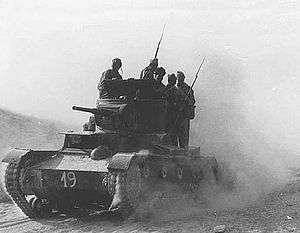
MacLean once said that various Communist figures meant more to him than any poet, writing in a letter to Douglas Young in 1941 that "Lenin, Stalin and Dimitroff now mean more to me than Prometheus and Shelley did in my teens".[20]:4 Other left-wing figures that inspired MacLean included James Connolly, an Irish trade union leader executed for leading the Easter Rising; John Maclean, Scottish socialist and pacifist;[lower-roman 13] and John Cornford, Julian Bell, and Federico García Lorca, who were killed by the Francoist regime during the Spanish Civil War.[20]:4 Many of these figures were not Gaels, and some critics have noted MacLean's unusual generosity to non-Gaelic people in his work.[12]:34 Perhaps the one uniting theme in his work is MacLean's anti-elitism and focus on social justice.[12]:37
Nevertheless, MacLean read widely and was influenced by poets from a variety of styles and eras. Of contemporary poets, Hugh MacDiarmid, Ezra Pound,[28] and William Butler Yeats had the greatest impact.[20]:3 After reading A Drunk Man Looks at the Thistle by MacDiarmid, MacLean decided to try his hand at extended narrative poetry, resulting in the unfinished An Cuilthionn.[22]:145 He was also influenced by the Metaphysical school. However, he "had nothing but contempt" for the popular left-wing poets of the 1930s, such as W. H. Auden or Stephen Spender, and sometimes regarded poetry as a useless aesthetic hobby.[20]:4
Dàin do Eimhir
In 1940, eight of MacLean's poems were printed in 17 Poems for 6d, along with Scots poems by Robert Garioch.[38]:154 The pamphlet sold better than expected and was reprinted a few weeks later; it received favorable reviews.[39] While MacLean was in North Africa, he left his poetry with Douglas Young, who had promised to help publish it.[21] In November 1943, the poems were published as Dàin do Eimhir agus Dàin Eile (English: Poems to Eimhir and Other Poems).[lower-roman 14] Dàin do Eimhir was a sequence of sixty numbered poems, with twelve missing;[lower-roman 15] of the other poems, the most significant was the long narrative poem An Cuilthionn.[39][lower-roman 16] The book marked a sharp break in style and substance of Gaelic poetry from earlier eras.[3] In his poetry, MacLean emphasized the struggle between love and duty, which was personified in the poet's difficulty in choosing between his infatuation with a female figure, Eimhir, and what he sees as his moral obligation to volunteer in the Spanish Civil War.[2][3]
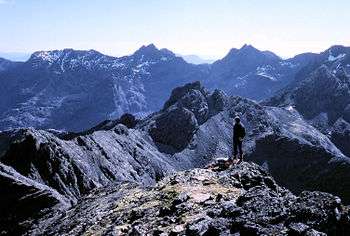
The book has been the subject of scholarly debate. Attempting to explain why MacLean's earlier poetry has had the greatest influence, Derick Thomson wrote that it is love poetry which is most timeless, while MacLean's political poetry has not aged as well.[3][lower-roman 17] According to Maoilios Caimbeul, "There is not, and I doubt there will ever be, a series of love poems" that would have as much influence on Gaelic literature.[lower-roman 18] Ronald Black suggested that "duty [is not]... a comprehensible emotion nowadays" and therefore " the greatest universal in MacLean’s verse is the depiction of that extraordinary psychosis which is called being in love".[41]:63 However, this type of commentary has been criticized as an attempt to depoliticize MacLean's work. Seamus Heaney argued that Eimhir was similar to Beatrice in Dante's Divine Comedy, in that Eimhir "resolves at a symbolic level tensions which would otherwise be uncontainable or wasteful".[12]:33-4[42] Scottish poet Iain Crichton Smith said, "there is a sense in which the Spanish Civil War does not form the background to these poems, but is the protagonist".[12]:31
MacLean's work was innovative and influential because it juxtaposed elements from Gaelic history and tradition with icons from mainstream European history. He described his poetry as "radiating from Skye and the West Highlands to the whole of Europe".[20]:4[31]:7 By this juxtaposition, he implicitly asserted the value of the Gaelic tradition and the right of Gaels to participate as equals in the broader cultural landscape.[2] According to John MacInnes, MacLean put the much-denigrated Gaelic language and tradition in its proper place, which has a profound effect on Gaelic-speaking readers and is fundamental to their reading of his poetry.[34]:393 An Cuilthionn, the mountains of Skye are used as a synecdoche for rifts in European politics, and the suffering of the Gaels due to the Highland Clearances is compared to the suffering of European people under Francoism and other fascist regimes.[2][28] MacLean frequently compared the injustice of the Highland Clearances with modern-day issues;[4]:133 in his opinion, the greed of the wealthy and powerful was responsible for many tragedies and social problems.[4]:134
The book won him recognition as "the major force in modern Gaelic poetry", according to The Cambridge Companion to British Poetry.[38]:153 Caimbeul writes that the poems "capture the uncertainty, pain, yearning, and the search for stability that are at the heart of Modernism".[lower-roman 19] Summarizing the impact of the book, Professor Donald MacAulay wrote, "After the publication of this book Gaelic poetry could never be the same again."[21]
Recognition
Although his poetry had a profound impact on the Gaelic-speaking world, it was not until the 1970s and 1980s that MacLean's work became accessible in English translation.[3][6]:193[lower-roman 20] He was "virtually unknown" until some of MacLean's poems were reproduced in a 1970 anthology with three other poets, Four Points of the Saltire.[28][39] Iain Crichton Smith published an English translation of Dàin do Eimhir in 1971.[lower-roman 21] He was part of the delegation that represented Scotland at the first Cambridge Poetry Festival in 1975, establishing his reputation in England.[13][17] MacLean was one of five Gaelic poets to be anthologized in the influential 1976 collection Nua-Bhàrdachd Ghàidhlig / Modern Scottish Gaelic Poems with verse translations by the authors. MacLean's verse translations were also included in later publications.[35]:60, 64, 73 In 1977, Canongate Books published Reothairt is Contraigh: Taghadh de Dhàin 1932-72 (English: Spring tide and Neap tide: Selected Poems 1932-72). MacLean changed the ordering of the poems in Dàin do Eimhir, altering many poems and omitting others. In the original version of An Cuilthionn, MacLean had called upon the Red Army to liberate Scotland.[lower-roman 22] This passage was expunged, among other alterations and omissions that led the Scottish Poetry Library to describe the 1977 version as having been "bowdlerized". MacLean said that he would only consent to publishing the parts of his older work that he found "tolerable". The critical acclaim and fame that MacLean achieved was almost entirely from critics that did not understand his poetry in the original Gaelic.[35]:172 In 1989, a further compilation of his poetry, O Choille gu Bearradh / From Wood to Ridge: Collected Poems in Gaelic and English won him lasting critical acclaim. Complete annotated editions of his work have since been published.[2]
From the early 1970s, MacLean was in demand internationally as a reader of his own poetry. He would start a reading of a poem by describing the images, then read the poem first in Gaelic and again in English, emphasizing that the translations were not to be read as poems in of themselves.[35]:72 His readings were described as deeply moving even by listeners who did not speak Gaelic;[12]:17 according to Seamus Heaney, "MacLean's voice had a certain bardic weirdness that sounded both stricken and enraptured".[42] Gaelic poet George Campbell Hay wrote in a review that MacLean "is gifted with what the Welsh call Hwyl, the power of elevated declamation, and his declamation is full of feeling."[15]:1 These readings helped establish his international reputation as a poet.[12]:30 MacLean's poetry was also translated into German, and he was invited to poetry readings in Germany and Austria.[35]:255
In the English-speaking world, MacLean's best-known poem is Hallaig, a meditation on a Raasay village which had been cleared of its inhabitants.[18]:442 Raasay was cleared between 1852 and 1854; most of its inhabitants were forced to emigrate. Many of MacLean's relatives were affected, and Hallaig was one of the villages to be depopulated. The poem was written a century later, during MacLean's time in Edinburgh,[25][43]:418 and originally published in 1954 in the Gaelic-language magazine Gairm.[39] Beginning with the famous line, "Time, the deer, is in the wood of Hallaig",[lower-roman 23] the poem imagines the village as it was before the Clearances, with the long-dead eternally walking through the trees.[43]:418-9 It is also filled with local names of individuals and places, which have deeper meanings to those intimately familiar with Raasay oral tradition.[12]:36 Unlike most of MacLean's output, Hallaig has no overt political references,[4]:128-129 and never directly mentions eviction or clearance.[28] For this reason, it was seen as politically "safer" than others of MacLean's poems. Translated and promoted by Irish Nobel Prize Laureate Seamus Heaney,[18]:13 Hallaig achieved "cult status"[4]:134 and came to symbolize Scottish Gaelic poetry in the English-speaking imagination.[18]:13
Style
MacLean's poetry generally followed an older style of meter, based on the more dynamic patterns of the oral tradition rather than the strict, static metres of the written Gaelic poetry of the nineteenth century.[34]:397 He frequently combined metrical patters and shifted in the middle of a poem, achieving "sensuous effects" that cannot be translated.[34]:398 He typically used the traditional vowel rhymes, both internal and end-rhymes, that are ubiquitous in the oral tradition, but a few of his poems have less traditional rhyme schemes.[34]:399 However, he was flexible in his use of metre, "[combining] old and new in such a way that neither neutralizes each other,"[lower-roman 24] extending rather than repudiating tradition, in a way that is unique in Gaelic poetry.[34]:400[31]:7 In MacInnes' analysis, "rhythmic patterns become a vital part of the meaning" of MacLean's poetry.[34]:414 Over time, his poems became less strict in their application of rhyme and metre.[34]:401 According to MacInnes, labels such as "classical" and "romantic", which have been applied respectively to the form and content of MacLean's poetry, are misleading because MacLean did not limit himself by those styles. Despite MacLean's reliance on the oral tradition, his poetry was not intended to be sung.[34]:402 Although he abandoned the "verbal codes" and intricate symbolism of the Gaelic tradition,[34]:416 MacLean occasionally used outmoded devices, such as the repeating of adjectives.[31]:6

MacLean's poetry frequently used Gaelic themes and references, such as place names, trees, and sea symbolism. A knowledge of that tradition would bring additional interpretations and appreciation to a reading of MacLean's poetry.[34]:407-8 Another important symbol in his work is the face, which represents romantic love.[41]:63
According to John MacInnes, MacLean's poetry "exhibits virtually an entire spectrum of language". Some of his poetry is transparent to a fluent Gaelic speaker, but the meaning of other poems needs to be untangled.[34]:393 MacLean coined very few neologisms;[1]:216[lower-roman 25] however, he revived or repurposed many obscure or archaic words.[34]:404-6[31]:6 MacLean often said that he had heard these old words in Presbyterian sermons.[34]:407 According to MacInnes and Maoilios Caimbeul, MacLean's revival of these old, forgotten Gaelic words revolutionized literary Gaelic, by adding senses and a newness and modernity.[34]:406[31]:6 Caimbeul wrote that MacLean's vocabulary is not "simple", but it is "natural" and arises naturally from everyday speech, although mixed with other influences.[31]:5
In contrast, the English translations were all written in a very straightforward style,[34]:394 flattening the language by the necessity to choose one English word for the ambiguity and connotations of the Gaelic one.[34]:406-7 According to Christopher Whyte, the English translations produce "an official interpretation, one that restricts and deadens the range of possible readings of the poem".[35]:96 English could not convey the pop that MacLean's revival of disused words brought to his Gaelic poetry.[34]:407 While the Gaelic poems were noted for their acoustic properties, the translations did not pay any particular attention to sound, instead focusing narrowly on literal meaning.[35]:249 MacLean emphasized that his "line-by-line translations" were not poetry;[15]:8[35]:257[lower-roman 26] Seamus Heaney called them "cribs".[42]
Awards and honours
In June 1987, MacLean became the first freeman of Skye and Lochalsh.[44] He received seven honorary degrees.[lower-roman 27] Twice, he was the honorary head of the Gaelic Society of Inverness, in 1970 and 1982; he was made honorary president of the Saltire Society in 1985.[45] In 1989, he became a Fellow of the Royal Society of Literature. The next year, he was named the first University of Edinburgh Alumnus of the Year,[10] and awarded a Queen's Gold Medal for Poetry.[2][3] O Choille gu Bearradh was the Saltire Society Scottish Book of the Year for 1990, and MacLean won the McVitie's Prize for Scottish Writer of the Year.[45] He became a Fellow of the Educational Institute of Scotland in 1991, a Fellow of the Royal Society of Edinburgh in 1992, an honorary fellow of the Royal Incorporation of Architects in Scotland in 1996, and an honorary Royal Scottish Academician the same year.[45] He was nominated for the Nobel Prize in Literature in 1992;[30][46]:2 it has been suggested that he might have won if he had not written in such a marginalized language.[47][48] MacLean is commemorated by a stone in Makars' Court, outside the Writers' Museum, Lawnmarket, Edinburgh, unveiled in 1998 by Iain Crichton Smith.[49]
Legacy
Hugh MacDiarmid wrote a letter to MacLean in 1977, a year before his death, stating that he and MacLean were the best Scottish poets of the twentieth century.[2] MacDiarmid and MacLean influenced each other's work and maintained an extensive correspondence which has been published.[50] Douglas Young wrote that "the best poetry written in our generation in the British Isles has been in Scottish Gaelic, by Sorley MacLean."[51]:229 John MacInnes called him a "magisterial writer" who "[pushed] Gaelic to its limits". He said that it is "truly astonishing" that Gaelic, so long minoritized, could have produced a writer like MacLean, who could not express what he had to say in any other language: "Somhairle MacGill-Eain needed Gaelic, and Gaelic needed Somhairle MacGill-Eain".[34]:417 According to Iain Crichton Smith, translator of MacLean's poetry, Dàin do Eimhir was "the greatest Gaelic book of this century", an assessment with which Christopher Whyte agreed.[35]:67 According to Maoilios Caimbeul, MacLean was the best Scottish Gaelic poet of all time.[31]:1 Smith compared the calibre of MacLean's love poetry to that of Catallus and William Butler Yeats. Nobel Prize Laureate Seamus Heaney said that MacLean had "saved Gaelic poetry... for all time".[3]
While acknowledging the literary merit of MacLean's work, Whyte suggested that it was unfortunate that in the 1980s it stood in for all Scottish Gaelic poetry in the Anglophone world. According to Whyte, MacLean's poetry is "comparatively unGaelic, elitist rather than populist, and permeable only with difficulty to the community which uses the language in its day to day existence".[35]:67-68 MacInnes concedes that MacLean does not cater to his readers; however, in his opinion it would be incorrect to call the poetry elitist because of its "artistic sincerity", speaking "with affective directness and a simple passionate intensity".[34]:417 Compounding the difficulty is that the traditional medium of Gaelic poetry is song, and many fluent speakers do not have strong reading skills.[35]:66-7[31]:3 In an effort to make MacLean's work more accessible to Scottish Gaelic speakers, the Sorley MacLean Trust commissioned several musicians[lower-roman 28] to set some of MacLean's poems to music.[53][54][31]:2
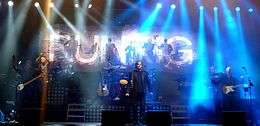
In the Gaelic-speaking world, MacLean's influence has been pervasive and persistent. Poet Aonghas MacNeacail started writing in English, because "My education gave me to believe that Gaelic literature was dead"; he credited MacLean with convincing him otherwise and inspiring him to write in Gaelic. The Gaelic rock band Runrig once invited MacLean to come onstage for a poetry reading.[47] However, MacLean had less impact on rural Gaelic-speaking communities. Novelist Angus Peter Campbell wrote that he preferred the work of local Uist bards to MacLean, and he believed that other Uist people felt the same.[35]:68 Australian poet Les Murray has acknowledged MacLean's influence on his work.[20]:5
A film, Hallaig, was made in 1984 by Timothy Neat, including a discussion by MacLean of the dominant influences on his poetry, with commentary by Smith and Heaney, and substantial passages from the poem and other work, along with extracts of Gaelic song.[6]:193 The poem also forms part of the lyrics of Peter Maxwell Davies' opera The Jacobite Rising;[55] and MacLean's own reading of it in English and in Gaelic was sampled by Martyn Bennett in his album Bothy Culture for a track of the same name.[56]
A controversy erupted in 2000, when John MacLeod, chief of Clan MacLeod, put the Cullin on the market in order to finance the repair of Dunvegan Castle. His real estate agency, Savills, used excerpts from An Cuilthionn to advertise the property. Many people found this to be an inappropriate use of MacLean's work. Savills apologized unreservedly, which was accepted by Renee MacLean.[57][58]
Selected works
- Poetry collections
- MacLean, Sorley; Garioch, Robert (1940). 17 Songs for 6d (in Scottish Gaelic and Scots). Edinburgh: Chalmers Press.
- MacGhill-Eathain, Somhairle (1943). Dàin do Eimhir agus Dàin Eile (in Scottish Gaelic). Glasgow: William Maclellan.
- MacLean, Sorley; Hay, George Campbell; Neill, William; MacGregor, Stuart (1970). Four points of a saltire (in English, Scots, and Scottish Gaelic). Edinburgh: Reprographia.
- MacLean, Sorley (1971). Smith, Iain Crichton, ed. Poems to Eimhir. London: Gollancz. ISBN 9780575007468.
- MacLean, Sorley; Hay, George Campbell; Smith, Iain Crichton; Thomson, Derick; MacAulay, Donald (1976). MacAulay, Donald, ed. Modern Scottish Gaelic Poems: Nua-Bhàrdachd Ghàidhlig (in English and Scottish Gaelic). Edinburgh: Southside. ISBN 9780811206310.
- MacLean, Sorley (1977). Reothairt is Conntràigh / Spring Tide and Neap Tide, 1932-72 (in English and Scottish Gaelic). Edinburgh: Canongate.
- MacLean, Sorley (1989). O choille gu bearradh: collected poems in Gaelic and English (in English and Scottish Gaelic). Manchester: Carcanet.
- MacGill-Eain, Somhairle (2002). Whyte, Christopher, ed. Dàin do Eimhir / Poems to Eimhir (in English and Scottish Gaelic). Glasgow: Association for Scottish Literary Studies. ISBN 9780948877506.
- MacGill-Eain, Somhairle (2011). Whyte, Christopher, ed. An Cuilithionn 1939: The Cuillin 1939 and Unpublished Poems (in English and Scottish Gaelic). Glasgow: Association for Scottish Literary Studies. ISBN 9781906841034.
- MacLean, Sorley (2011). Whyte, Christopher; Dymock, Emma, eds. Caoir Gheal Leumraich / White Leaping Flame: collected poems in Gaelic with English translations (in English and Scottish Gaelic). Edinburgh: Polygon.
- Literary criticism
- MacGill-Eain, Somhairle (1985). Gillies, William, ed. Ris a' Bhruthaich: Criticism and Prose Writings. Stornoway: Acair. ISBN 9780861520411.
References
Notes
- 1 2 Gaelic patronymic: Somhairle mac Chaluim 'ic Chaluim 'ic Iain 'ic Tharmaid 'ic Iain 'ic Tharmaid.[1]:211
- 1 2 Scottish Gaelic pronunciation: [ˈs̪o.ərˠlə maxˈkʲiʎɛhɛɲ]
- ↑ As MacLean put it in a letter to Hugh MacDiarmid, "A renegade Seceder makes quite a good Marxist".[16]:218[17]
- ↑ MacInnes wrote that "It is perfectly clear that he would not be the kind of poet he is if he had ignored the impassioned eloquence of the Church".[11]:239
- ↑ MacLean later regretted his decision to study English: "By the time I was in my second year I was greatly sorry I was taking a degree in English because I was interested only in poetry and only in some poetry at that. I wasn’t interested in prose and I was sorry I didn’t do Hons. Gaelic."[19]
- ↑ Of North Africa, he later said, "It wasn't a very pleasant place".[15]:5
- ↑ In one of his poems, Latha Fogair ("An Autumn Day"), MacLean satirizes the Calvinist doctrine of unconditional election by describing an explosion of a mine which killed six of his comrades but, for no particular reason, spared MacLean.[12]:35
- ↑ Cameron's mother was not of Gaelic ancestry, but her father, an Inverness joiner, was raised in Kilmuir on the Black Isle when it was still Gaelic-speaking.[24]
- ↑ According to MacLean, the number of students studying Gaelic "doubled, trebled, quadrupled, and more" as a result of the learners' exam becoming available.[5]:34
- ↑ Fully Gaelic medium education, with all subjects taught in Gaelic, was inaugurated in 1985.[27]:119
- ↑ He later described his English poetry as "mostly imitative of Eliot and Pound... over-sophisticated, over-self-conscious".[33]:5
- ↑ In 1943, he wrote in a letter to Hugh MacDiarmid: "The whole prospect of Gaelic appals me, the more I think of the difficulties and the likelihood of its extinction in a generation or two. A ... language with ... no modern prose of any account, no philosophical or technical vocabulary to speak of, no correct usage except among old people and a few university students, colloquially full of gross English idiom lately taken over... (what chance of the appreciation of the overtones of poetry, except amongst a handful?)"[37]:4
- ↑ According to MacLean, two of his maternal uncles had met John Maclean.[5]:33
- ↑ Dàin do Eimhir was published primarily in Gaelic, but included MacLean's prose translations of some poems in a smaller font.[39][35]:57
- ↑ Some poems were omitted because MacLean doubted their quality; others were left out due to their personal content.[15]:5 He asked Young to destroy the unpublished poems, but Young refused. All but one poem survived to be published in Christopher Whyte's critical edition in 2002.[40]:73
- ↑ An Cuilthionn was written between 1939 and 1940, never finished, but published anyway.[28]
- ↑ Ronald Black disagreed with this analysis, citing a student of his who chose MacLean's little-known poem A' Ghort Mhòr (English: The Great Famine) for a class presentation. Asked why, she replied, "it is relevant to today, rather than all that stuff about love".[41]:74
- ↑ "Chan eil, agus tha teagamh agam nach bi, sreath de dhàin ghaoil ann an litreachas na Gàidhlig a thig an uisge-stiùrach nan dàn seo."[31]:5
- ↑ "Tha e a’ ciallachadh gu bheil na Dàin seo a’ glacadh a’ mhì-chinnt, am pian, an sireadh, an t-iarraidh airson nì seasmhach a tha aig cridhe Nuadhachais".[31]:7
- ↑ His poetry was not very accessible to Gaelic speakers either, since Dàin do Eimhir was not reprinted.[31]:2
- ↑ This edition only contained 36 of the poems in the Eimhir sequence,[39] and did not reproduce the Gaelic originals.[35]:62
- ↑ "Có bheir faochadh dhan àmhghar
mur tig an t-Arm Dearg sa chàs seo?"
(Who will give respite to the agony
unless the Red Army comes in this extremity?)[2] - ↑ Scottish Gaelic: Tha tìm, am fiadh, an coille Hallaig
- ↑ Caimbeul writes, "ceòlmhor ann an dòigh a tha sean agus ùr",[31]:7 meaning, roughly, "musical in both old and new ways".
- ↑ MacInnes said that he could not find a single neologism in all of MacLean's poetry.[34]:404
- ↑ MacLean was ambivalent to his own translations: of the prose translation of An Cuilthionn that appeared in Dàin do Eimhir, he wrote, "my English version has not even the merit of very strict literal accuracy as I find more and more when I look over it".[35]:257
- ↑
- L.L.D., University of Dundee 1972
- D.Litt., Celt, the National University of Ireland 1979
- D.Litt., University of Edinburgh 1980
- D.Univ., Open University 1989
- D.Univ., University of Grenoble 1989
- D.Phil., Anglia Polytechnic 1994
- D.Litt., University of Glasgow 1996[45]
- ↑ Stuart MacRae, Mary Ann Kennedy, Eilidh Mackenzie, Marie-Louise Napier, Allan Macdonald, Blair Douglas, Allan Henderson, Donald Shaw, and Kenneth Thomson[52]
Citations
- 1 2 3 4 5 MacDonald, Donald Archie (1986). "Some Aspects of Family and Local Background: an Interview with Sorley MacLean" (PDF). In Raymond J. Ross and Joy Hendry. Sorley MacLean: Critical Essays. Edinburgh: Scottish Academic Press. pp. 211–222.
- 1 2 3 4 5 6 7 8 9 10 11 12 "Sorley MacLean". Scottish Poetry Library. Retrieved 17 August 2018.
- 1 2 3 4 5 6 7 8 9 10 11 12 13 14 15 16 17 18 "20mh linn– Am Bàrd: Somhairle MacGill-Eain". BBC Alba – Làrach nam Bàrd (in Scottish Gaelic). Retrieved 17 August 2018.
- 1 2 3 4 5 6 7 Poncarová, Petra Johana (5 January 2015). "Sorley MacLean's Other Clearance Poems". Studies in Scottish Literature. 43 (1): 124–134.
- 1 2 3 4 5 6 Nicolson, Angus (1979). "An Interview with Sorley MacLean". Studies in Scottish Literature. 14 (1): 23–36. ISSN 0039-3770.
- 1 2 3 Beard, David; Gloag, Kenneth; Jones, Nicholas (2015). Harrison Birtwistle Studies. Cambridge University Press. ISBN 9781107093744.
- 1 2 Shaw, John (2017). "Calum Maclean Project". The University of Edinburgh. Retrieved 20 August 2018.
- 1 2 3 4 5 "Life - A Raasay Childhood (1911 - 1929)". Sorley MacLean online. Archived from the original on 2013-07-14. Retrieved 2018-01-06.
- 1 2 3 4 5 6 7 8 Gillies, William. "Sorley MacLean" (PDF). Royal Society of Edinburgh. Retrieved 21 August 2018.
- 1 2 3 4 5 6 7 8 "Alumni in history: Sorley Maclean (1911–1996)". University of Edinburgh. Retrieved 30 November 2015.
- 1 2 3 4 5 6 Ó Fuaráin, Pádraig (2007). "Landscape in the Poetry of Sorley MacLean". In Mac Mathúna, Séamus; Ó Corráin, Ailbhe; Fomin, Maxim. Celtic Literatures in the Twentieth Century (PDF). Research Institute for Irish and Celtic Studies University of Ulster.
- 1 2 3 4 5 6 7 8 9 10 11 12 13 14 15 16 17 18 19 20 21 22 23 Calder, Angus (2016). "The poetry of Sorley MacLean". Open University.
- 1 2 3 Macrae, Alasdair (1996-11-26). "Obituary: Sorley MacLean". The Independent. Retrieved 2018-01-06.
- ↑ MacLean, Sorley (1 November 1994). "Hallaig". PN Review. 21 (2): 10.
- 1 2 3 4 5 6 7 8 Nicholson, Colin (1 January 1987). "Poetry of Displacement: Sorley MacLean and his Writing". Studies in Scottish Literature. 22 (1).
- ↑ Wilson, Susan Ruth (2007). Higgins, Iain, ed. Hugh MacDiarmid and Sorley MacLean: Modern Makars, Men of Letters (Thesis). University of Victoria.
- 1 2 3 4 5 6 7 8 Ross, David (15 October 2011). "A personal eulogy for Sorley MacLean". Herald Scotland. Retrieved 20 August 2018.
- 1 2 3 4 O’Gallagher, Niall (5 September 2016). "Ireland's eternal Easter: Sorley MacLean and 1916". Irish Studies Review. 24 (4): 441–454. doi:10.1080/09670882.2016.1226678.
- 1 2 3 4 "University Days". The Sorley MacLean Trust. Retrieved 18 August 2018.
- 1 2 3 4 5 6 7 8 9 10 11 12 13 14 MacRae, Alasdair (2007). "Sorley MacLean in Non-Gaelic Contexts" (PDF).
- 1 2 3 4 5 6 7 "Out of Skye to the World (1934-1943)". The Sorley MacLean Trust. Retrieved 18 August 2018.
- 1 2 3 4 Day, Gary; Docherty, Brian (1997). British Poetry from the 1950s to the 1990s: Politics and Art. Springer. ISBN 9781349255665.
- 1 2 Cheape, Hugh (2016). "'A mind restless seeking': Sorley MacLean's historical research and the poet as historian" (PDF). In R. W. Renton and I. MacDonald. Ainmeil thar Cheudan. An t-Eilean Sgitheanach: Sabhal Mòr Ostaig, Clò Ostaig. pp. 121–134.
- 1 2 Ross, David (13 March 2013). "Renee Maclean (obituary)". The Herald. Retrieved 18 August 2018.
- 1 2 3 "Edinburgh (1943-1956)". The Sorley MacLean Trust. Retrieved 20 August 2018.
- 1 2 3 4 "Plockton (1956-1969)". The Sorley MacLean Trust. 18 January 2013. Retrieved 19 August 2018.
- ↑ Milligan Dombrowski, Lindsay; Danson, Eilidh; Danson, Mike; Chalmers, Douglas; Neil, Peter (28 August 2013). "Initial teacher education for minority medium-of-instruction teaching: the case study of Scottish Gaelic in Scotland". Current Issues in Language Planning. 15 (2): 119–132. doi:10.1080/14664208.2013.811006. ISSN 1466-4208.
- 1 2 3 4 5 6 7 "Writing Scotland - Sorley MacLean". BBC. Retrieved 17 August 2018.
- 1 2 "The Harvest of his Genius". The Sorley MacLean Trust. Retrieved 20 August 2018.
- 1 2 "Death of poet Sorley MacLean". The Irish Times. 25 November 1996.
- 1 2 3 4 5 6 7 8 9 10 11 12 13 14 Caimbeul, Maoilios (2007). "Feartan ann am bardachd Shomhairle MhicGill-Eain" (PDF) (in Scottish Gaelic). The Sorley MacLean Trust.
- ↑ "Sir Iain Noble Memorial Lecture recalls life of poet Sorley MacLean". The Stornoway Gazette. 26 November 2016. Retrieved 18 August 2018.
- ↑ Ó Fuaráin, Pádraig (1994). Somhairle Mac Gill-Éain agus Seán Ó Ríordáin: Friotal, Creideamh, Moráltacht (PDF) (Thesis) (in Irish). Modern Irish department, St Patrick's College, Maynooth.
- 1 2 3 4 5 6 7 8 9 10 11 12 13 14 15 16 17 18 19 20 21 22 23 24 25 MacInnes, John (2006). "Language, Metre and Diction in the Poetry of Sorley MacLean". In Newton, Michael. Dùthchas nan Gàidheal: Selected Essays of John MacInnes. Edinburgh: Birlinn Ltd. pp. 392–417.
- 1 2 3 4 5 6 7 8 9 10 11 12 13 14 15 16 Krause, Corinna (2007). Eadar Dà Chànan: Self-Translation, the Bilingual Edition and Modern Scottish Gaelic Poetry (PDF) (Thesis). The University of Edinburgh School of Celtic and Scottish Studies.
- ↑ MacAulay, Donald (1992). The Celtic Languages. Cambridge University Press. ISBN 978-0521231275.
- 1 2 Krause, Corinna. "Translating Gaelic Scotland: the culture of translation in the context of modern Scottish Gaelic literature" (PDF). University of Edinburgh.
- 1 2 Riach, Alan (2015). "Scottish Poetry, 1945-2010". In Larrissy, Edward. The Cambridge companion to British poetry, 1945-2010. Cambridge University Press. pp. 148–162. ISBN 9781316111314.
- 1 2 3 4 5 6 "Publications". The Sorley MacLean Trust. Retrieved 19 August 2018.
- ↑ Begnal, Michael S. (2002). "Gràdh, Grá, Grá". The Poetry Ireland Review (75): 73–77. JSTOR 25580090.
- 1 2 3 Black, Ronald (2007). "Twentieth Century Scottish Gaelic Poetry". In Mac Mathúna, Séamus; Ó Corráin, Ailbhe; Fomin, Maxim. Celtic Literatures in the Twentieth Century (PDF). Research Institute for Irish and Celtic Studies University of Ulster.
- 1 2 3 Heaney, Seamus (30 November 2002). "Seamus Heaney celebrates Sorley MacLean". the Guardian.
- 1 2 MacInnes, John (2006). "Hallaig: A Note" (PDF). In Newton, Michael. Dùthchas nan Gàidheal: Selected Essays of John MacInnes. Edinburgh: Birlinn Ltd. pp. 418–421.
- ↑ "Freedom of Skye". The Glasgow Herald. 15 June 1987. p. 3. Retrieved 15 December 2016.
- 1 2 3 4 "Distinctions and honours". The Sorley MacLean Trust. Retrieved 20 August 2018.
- ↑ "Certain Ither Maitters / Brave New Words". 2007. Retrieved 18 August 2018.
- 1 2 "Sorley MacLean: A Salute to the saviour of Gaelic verse". The Scotsman. 14 June 2011. Retrieved 19 August 2018.
- ↑ MacNeil, Kevin. "Book review: Sorley MacLean". The Scotsman. Retrieved 22 August 2018.
- ↑ "Makars' Court". Museums and Galleries Edinburgh. Retrieved 17 August 2018.
- ↑ "The Correspondence Between Hugh MacDiarmid and Sorley MacLean: An Annotated Edition". Oxford University Press. 8 April 2010. Retrieved 17 August 2018.
- ↑ Van Eerde, John; Williamson, Robert (1978). "Sorley MacLean: A Bard and Scottish Gaelic". World Literature Today. 52 (2): 229–232. doi:10.2307/40132748. JSTOR 40132748.
- ↑ "Hallaig: A Musical Celebration of the Poetry of Sorley MacLean" (PDF). The Sorley MacLean Trust. Retrieved 19 August 2018.
- ↑ Mathieson, Kenny. "Blas 2011: Hallaig, A Musical Celebration of Sorley MacLean". Retrieved 18 August 2018.
- ↑ "Hallaig - A Celebration of Sorley MacLean" (PDF). Urras Shomhairle - The Sorley MacLean Trust. Retrieved 18 August 2018.
- ↑ McGregor, Richard (2017). Perspectives on Peter Maxwell Davies. Routledge. p. 90. ISBN 9781351554350.
- ↑ "Obituary: Martyn Bennett". The Independent. Retrieved 17 August 2018.
- ↑ MacQueen, H. "(86) Sorley Maclean, copyright and the sale of mountains". Scots Law News. Retrieved 30 August 2018.
- ↑ Ross, David (12 October 2000). "Cuillins seller apologises to poet's family; Use of Sorley Maclean's poem in advertising literature 'not appropriate'". Herald Scotland.
External links
| Wikiquote has quotations related to: Sorley MacLean |
| Wikimedia Commons has media related to Sorley MacLean. |
- Article summarizing a lecture by Heaney on Hallaig and MacLean's writing.
- Sorley Maclean's Island full-length documentary at the Scottish Screen Archive.
- Paper discussing Young's Scots translations of MacLean's poetry.
Further reading
- Devlin, Brendan P. (1977) 'On Sorley MacLean' Lines Review 61, June, 5–19.
- Herdman, John. (1977) 'The Poetry of Sorley MacLean: a non-Gael's view.' Lines Review 61, June, 25–36.
- Ross, R.J. & J. Hendry (ed.) (1986) Sorley MacLean – Critical Essays Edinburgh: Scottish Academic Press Ltd.
- Caimbeul, Aonghas Pàdraig (ed.). Somhairle – Dàin is Deilbh. A Celebration on the 80th Birthday of Sorley MacLean. Stornoway: Acair, 1991.
- Thomson, Derick (1994) The Companion to Gaelic Scotland Glasgow: Gairm Publications.
- Mackay, Peter (2010) Sorley MacLean Aberdeen: AHRC Centre for Irish and Scottish Studies.
- Dymock, Emma (2011) Scotnotes: The Poetry of Sorley Maclean Glasgow: Association of Scottish Literary Studies.
